Whether playing against a high press or a low block, the role of the centre-backs is key in the build-up phase and breaking the first line of pressure. Playing out from the back involves much more than simply being comfortable on the ball. The modern centre-back must be equipped in various ways to beat their direct opponent. This tactical analysis explores the tactical and technical nuances modern centre-backs utilise during the build-up phase.
This tactical theory will analyse the role of centre-backs within teams’ tactics and the individual actions that help them progress the ball. This analysis also offers training session ideas that allow centre-backs to work on these elements of their game.
Attacking the space
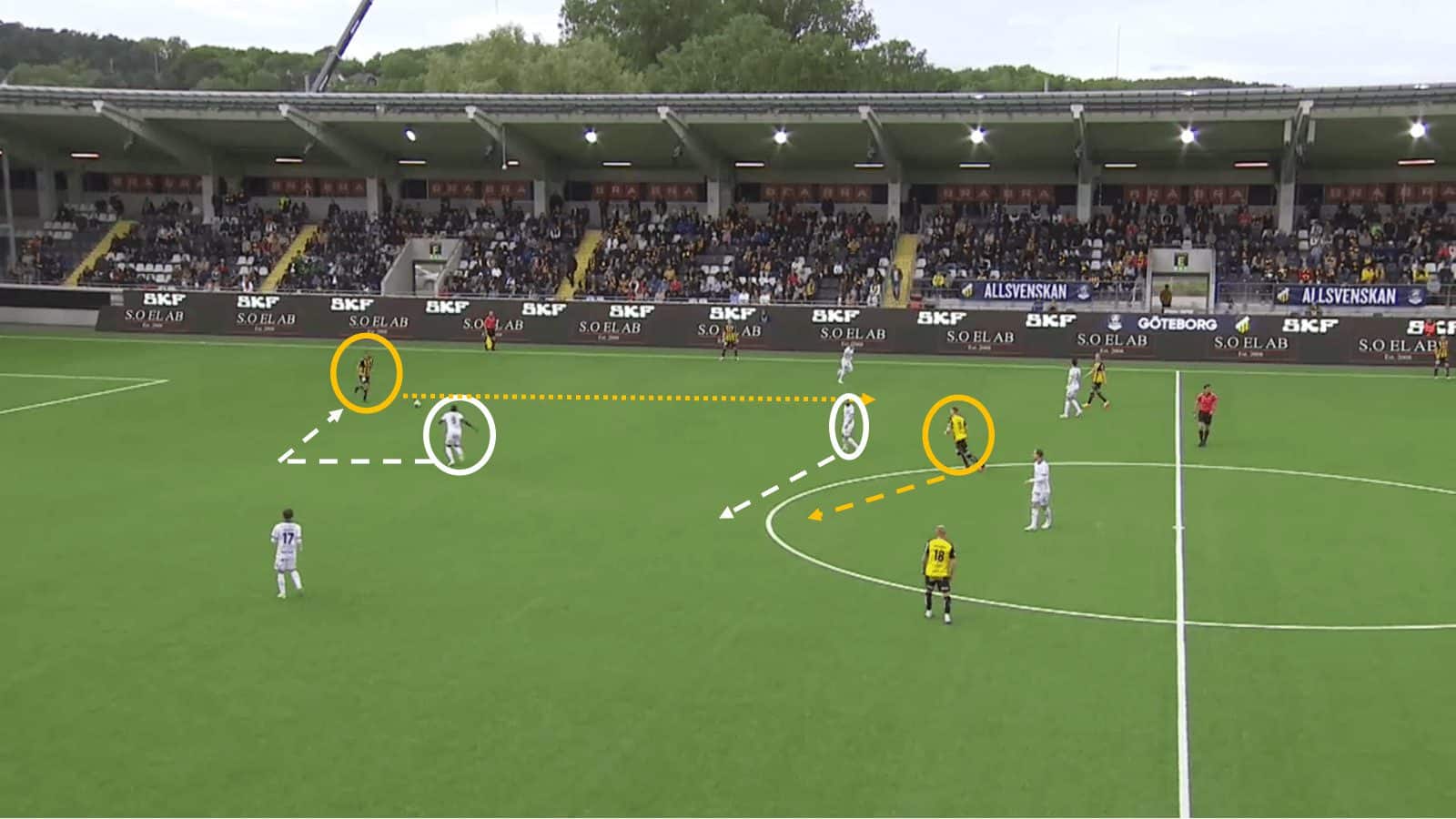
One of the most effective ways a centre-back can beat the first line of pressure is to carry the ball at their feet. Not only does it take the defender passed the opposition’s forward line, but it can also create an overload in midfield. At some point, the opposition’s central midfielder is forced to engage with the player on the ball, opening up passing options.
In the above example, taken from Häcken in the Swedish Allsvenskan, the left centre-back has just received the ball from his left-back. The ball-near opposition striker is attempting to cut the field in half and trap the centre-back on that side. The centre-back takes a big, aggressive first touch, removing the striker from the game. Aided by his central midfielders movement (circled), the centre-back takes the ball beyond the first line of pressure and is free to run at the opposition’s midfield.
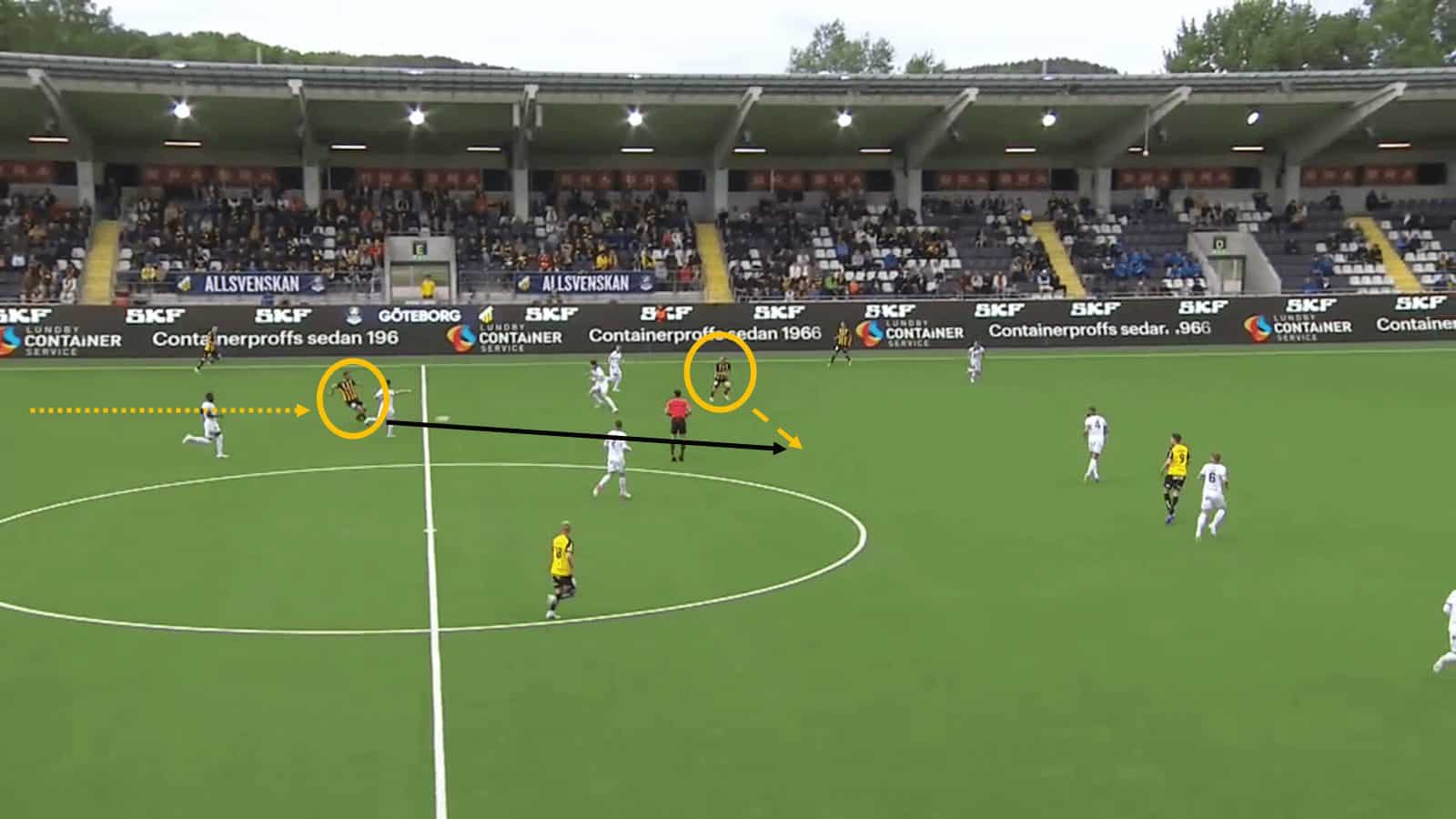
Now, with the opposition midfielders’ eyes focused on the ball, his teammate can sneak behind them from a wide to a central position. The wide player can move unnoticed and receive a pass that allows him to go directly at the opposition’s backline.
Attacking the space from a switch of play
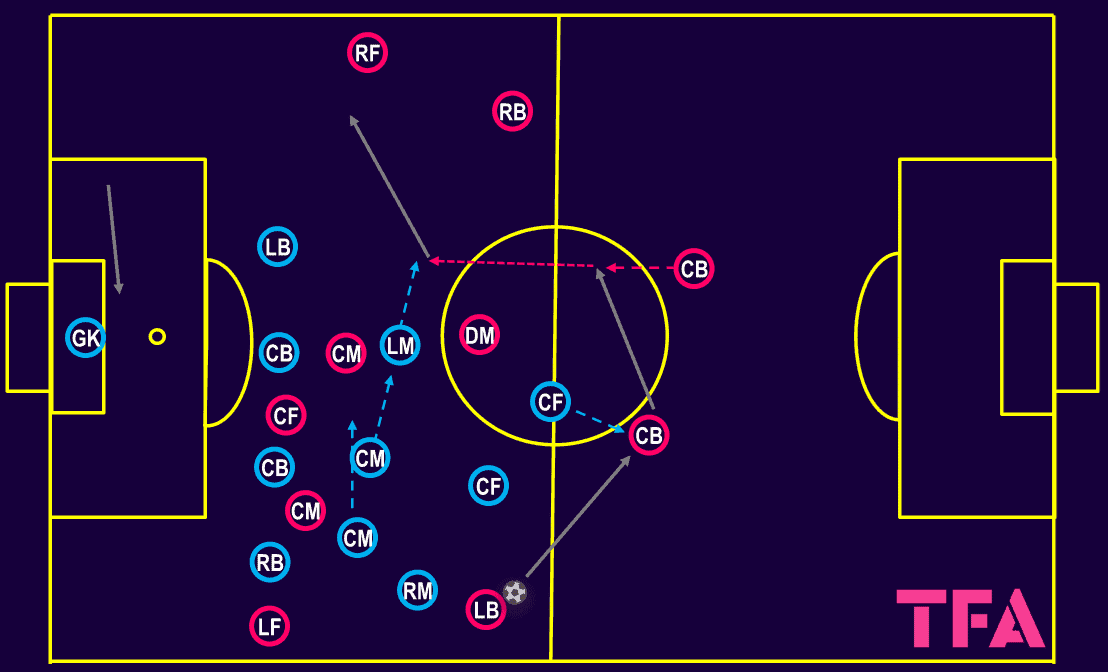
The above tactical diagram shows the benefits of attacking the space from a switch of play against a mid or low block. In addition to bypassing the first line of pressure, this makes it very difficult for the opposition’s midfield to shift across the pitch behind their forwards. Thus, space remains in the wide area, which could lead to a one-on-one situation between the winger and the opposition full-back.
The centre-back must take an aggressive first touch forward and must also continue driving forward in a straight line, as opposed to a diagonal line towards the next pass. This will usually lead to the widest, in this case, left, midfielder running directly to the ball. At the point of engagement, the centre-back can release the ball to one of the wide players.
An alternative for centre-backs to travel with the ball into space is to dribble the ball towards the closest opposition forward. Similar to the previous scenario described, this freezes the forward in place. By stopping the forwards from shifting to cover space, passing options behind the forward are created.
Foot on the ball
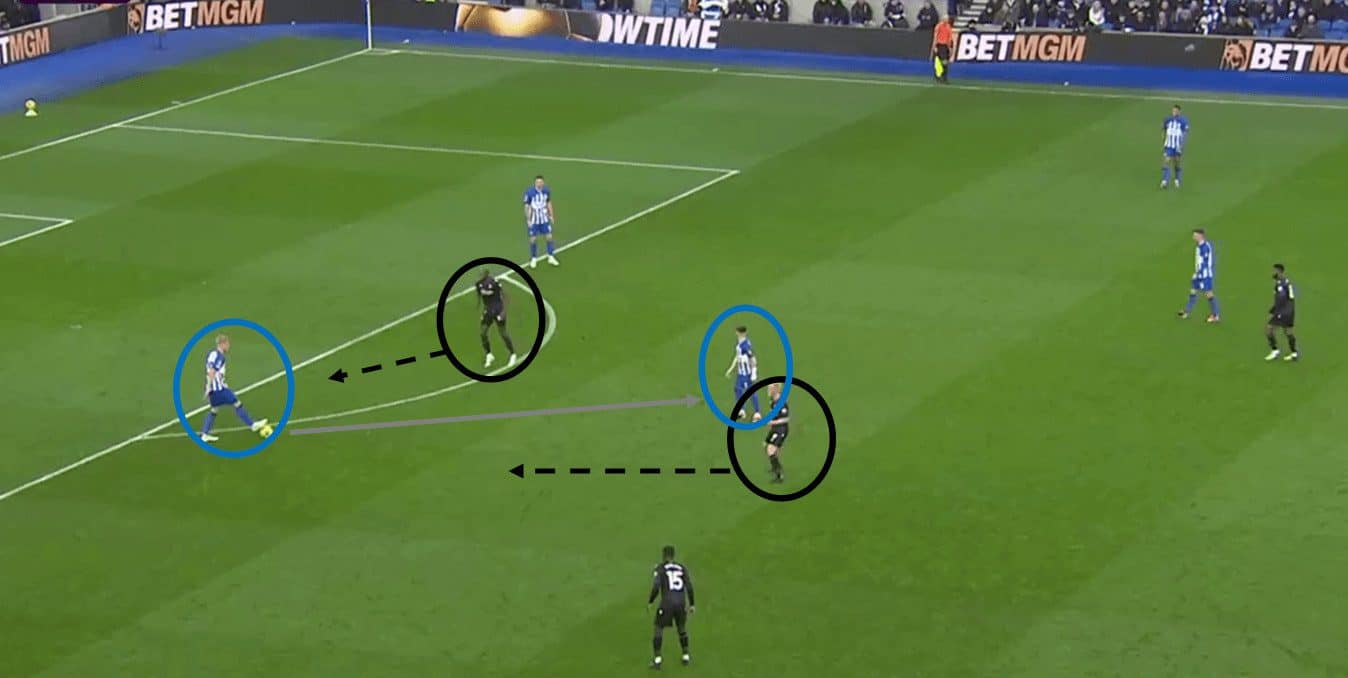
The above image shows Brighton’s Jan Paul van Hecke standing still at the edge of his box with the sole of his foot on the ball. This tactic has become increasingly common in the Premier League, with De Zerbi, having brought it with him from Serie A, being a particular proponent of the technique.
A centre-back doing this is usually to bait the forward into pressing the ball. When playing against a compact mid-block, this draws the forward ahead of his line of confrontation and creates space behind him. The forward jumping prematurely is the trigger for the in-possession team’s midfielders’ movements. Even at the top level, where teams are prepared to face this situation, it is very hard to resist the temptation to jump, especially when impatient fans are on your back.
In this situation, much closer to Brighton’s own goal, Van Hecke does not have any clear passing options. Crystal Palace are in complete control of the situation. It is only when van Hecke puts his foot on the ball that both forwards closest to the ball lose their patience and jump at the defender. This gives the Dutch centre-back a simple 10-yard pass to his midfielder, Billy Gilmour. The former Chelsea player can then receive acres of space and do as he likes with the ball.
From a technical standpoint, controlling the ball under the sole of the foot makes it easier to play the next pass. It is a common technique found in the very technical game of futsal. In different situations than the above, it can be used to protect the ball. It’s an effective way of keeping the ball far from the defending player whilst allowing the in-possession player to turn easily.
In this scenario, it allows the ball to be quickly rolled to either side, depending on where the pressure comes from, to set up a line-breaking pass. The ball can even be manipulated if the centre-back is forced to go sideways or backwards to the goalkeeper. The preciseness of the sole of the foot roll allows the next action to be a firm pass on the ground or even a long, high ball in behind.
Although this looks easy and is simple enough to understand, having the composure to stand on the ball in this situation is rare. It takes patience as well as trust in your teammates to make movements as soon as the opposition engages in their press.
Passing exercise
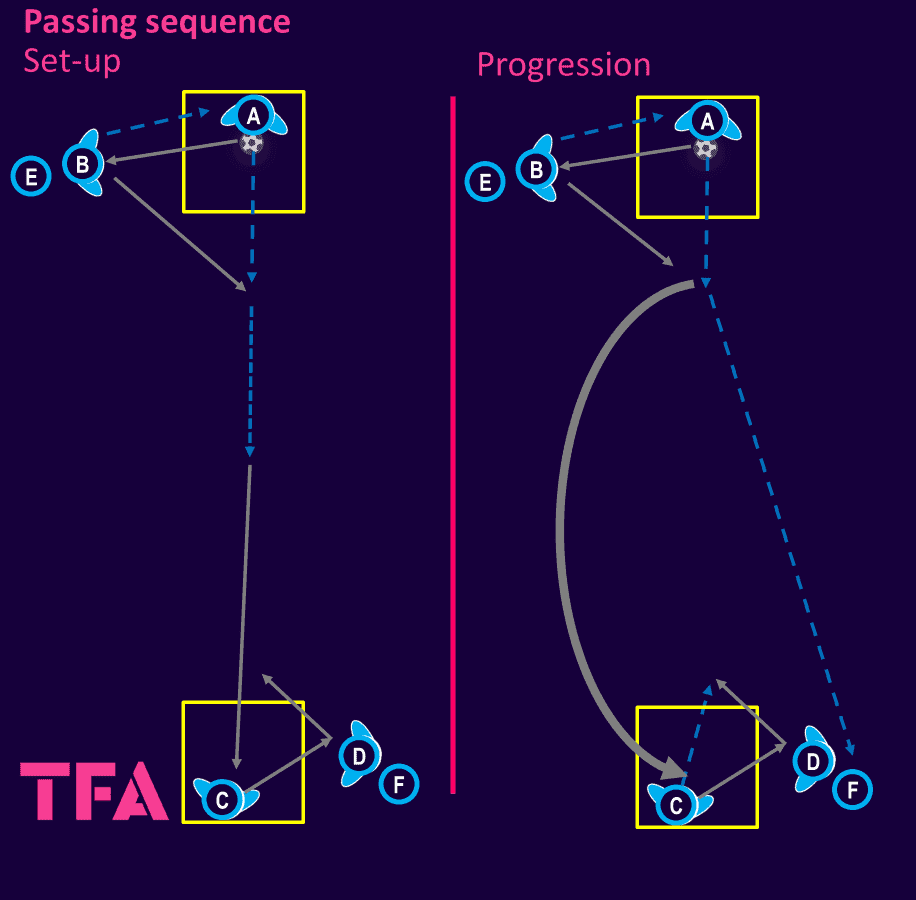
The practices described in this section are designed to work on the individual technical elements and decision-making of centre-backs. This simple passing exercise, which can be incorporated as part of a warm-up, allows defenders to work on attacking the space ahead of them before playing a firm, line-breaking pass. The drill can be progressed for players to work on their long balls and control the ball out of the air.
The team should be split into groups of between six and eight players, with those players being split evenly between two boxes. The exercise starts with player ‘A’ playing a one-two with player ‘B’ before “attacking the space” and dribbling forward, at pace, with the ball. When player ‘A’ reaches halfway, they should play a firm, inside-of-the-foot pass to player ‘C’. ‘A’ then moves to the side of the opposite box behind player ‘F’. ‘C’ then plays a one-two with ‘D’, and the sequence repeats. The size of the area can be adapted depending on the age and level of the players working with.
Players should be encouraged to dribble with their heads up as much as possible between touches. They should also be told to focus on the firmness and accuracy of their pass, which is meant to replicate a line-breaking pass being punched into one of their midfielders.
Directional possession
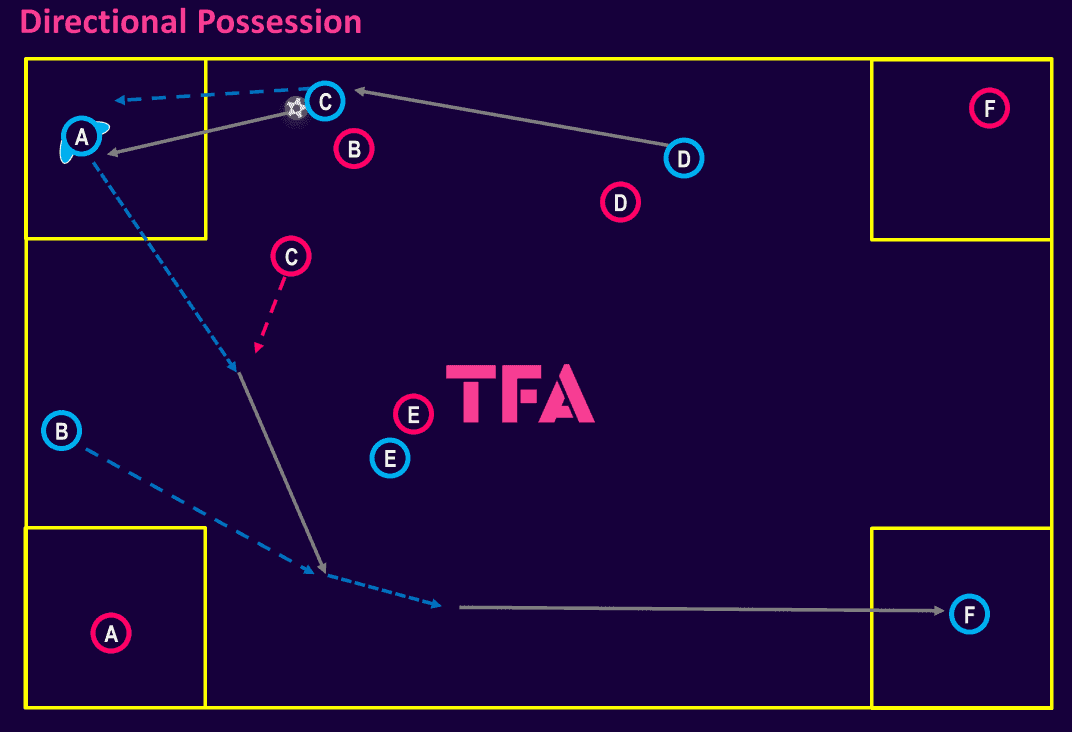
This possession game is designed to mimic the situations centre-backs face whilst playing out from the back under pressure. The aim of the exercise is for the in-possession team to connect from one corner box containing one of their players to the other box diagonally opposite, containing another one of their players. The game remains in constant flow, with the in-possession team always attempting to switch the play from one side to the other until they lose the ball. The attacking team gains a point every time they connect with the box player on the opposite side from the last box player to receive.
Players in the corner boxes must remain there until they receive the ball. These players represent the centre-backs. They must decide if the situation calls for them to attack the space (shown above) or put their foot on the ball and invite pressure. When the ball enters one of the corner boxes, it is live, meaning they can be pressed. After they release the ball, whoever passes the ball into their box takes that player’s place.
The speed of play can be increased by making all players, except the one escaping the box, only allowed two touches. The ‘centre-backs’ should be encouraged to make quick, decisive decisions and not hesitate should they choose to dribble out of their box. Their teammates should be coached in movements that either create space for their centre-back or enable them to play a pass.
Conclusion
The role of the centre-back in build-up play at the highest level is becoming increasingly complex. Centre-backs must be versatile in possession as they are often being asked to perform skills traditionally reserved for players higher up the pitch. In addition to their defensive duties, the complete modern centre-back needs to have a wide range of short and long passing. In addition, they must be capable of progressing the ball out of the back with it at their feet. They also need to possess the composure required to stand on the ball and invite pressure.






Comments